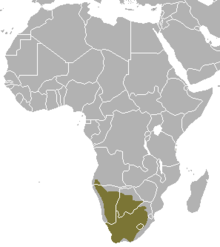Cape fox
| Cape fox | ||||||||||||
|---|---|---|---|---|---|---|---|---|---|---|---|---|

Cape fox couple with young animal in front of their cave in Namibia. |
||||||||||||
| Systematics | ||||||||||||
|
||||||||||||
| Scientific name | ||||||||||||
| Vulpes chama | ||||||||||||
| ( Smith , 1833) |
The Cape fox ( Vulpes chama ) is the only real fox and the smallest canine in southern Africa . It is also known as the Chama fox, Kama fox, or silverback fox.
features

The Cape fox has a silver-gray fur with a light yellow tinge on the flanks and the belly side. The large ears and the dark mouth region are characteristic. The tail is bushy. The Cape fox's shoulder height is only 35 cm and its weight is 2.5–3 kg. The tooth formula is 3 / 3-1 / 1-4 / 4-2 / 3 = 42.
distribution
The Cape fox is distributed from South Africa , with the exception of the coastal region on the Indian Ocean and the northeast, over the southwestern half of Botswana , Namibia (not in the coastal area) to the extreme southwest of Angola . It also occurs in Lesotho . It lives in open terrain, in savannas , thorn bush savannahs , semi-deserts and in fynbos .
Way of life
The Cape fox is nocturnal, usually hunts alone, and usually lives monogamous or in a small group of related animals in which two females tend to the young. It feeds on mice, lizards, insects (especially beetles and termites ) and other small animals, carrion and fruits. Occasionally it also catches hares. When hunting, it can reach a high speed and uses its tail as a counterweight to the torso when making quick turns. The young, usually one or two, are born in early summer after a gestation period of 51 to 52 days.
The Cape fox's predators are leopards , brown hyenas , desert lynx and honey badgers . They compete with meerkats for their burrows and can be driven out of their burrows by a targeted attack by a larger group of meerkats.
Systematics
|
Phylogenetic classification of the genus Vulpes
|
The first scientific description of the Cape fox comes from Andrew Smith in 1833. Today it is classified in the genus Vulpes along with eleven other species . On the basis of morphological and molecular biological data, it was developed by Binninda-Emonds et al. 1999 classified in a common group with the Bengal fox ( V. bengalensis ) and the pale fox ( V. pallida ) and compared to the remaining species of foxes as a sister group .
Its ancestry can be traced back to the late Miocene , about ten million years ago , together with other species of the Vulpes genus . It is not known when it split off from the other Vulpes species.
Apart from the nominate form , no subspecies are distinguished.
Threat and protection
The International Union for Conservation of Nature and Natural Resources (IUCN) classifies the species as “Least Concern”, as an acute threat to the stocks is not assumed. The species is considered to be widespread in the areas of central and western South Africa and has even been able to expand its range in recent decades. It is common within the distribution area, but locally there may have been reductions within the populations due to stock controls .
supporting documents
- ↑ a b Jan AJ Nel: Wild dogs . Ed .: Udo Gansloßer, Claudio Silleo-Zubiri. tape . Filander Verlag, 2006, ISBN 3-930831-63-5 , Der Kapfuchs, p. 69 ff .
- ↑ a b O.RP Binninda-Emonds, JL Gittleman, A. Purvis: Building large trees by combining phylogenetic information: a complete phylogeny of the extant carnovora (Mammalia). Biological Reviews of the Cambridge Philosophical Society 74, 1999; Pp. 143-175.
- ↑ a b c Don E. Wilson & DeeAnn M. Reeder (eds.): Vulpes chama in Mammal Species of the World. A Taxonomic and Geographic Reference (3rd ed).
- ↑ a b Vulpes chama in the IUCN Red List of Endangered Species 2012.2. Posted by: C. Stuart, T. Stuart, 2008. Retrieved April 1, 2013.
literature
- Gus Mills & Lex Hes: Mammals of Southern Africa. An illustrated encyclopedia. Ullmann publishing house, Cologne 1999, ISBN 3 8290 3610 8
Web links
- Vulpes chama inthe IUCN 2012 Red List of Threatened Species . 2. Posted by: C. Stuart, T. Stuart, 2008. Retrieved April 1, 2013.
